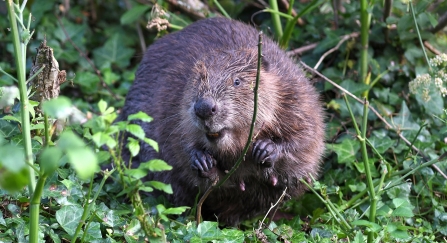We urgently need novel, affordable ways to halt and reverse the current declines in our wildlife, and there is abundant research evidence (notably from the University of Exeter) to suggest that beavers - through their physical modification of river catchments – would be cost-effective allies in achieving those aims. In our current climate crisis, with predictions of an increased frequency of severe weather events, beaver-modified landscapes will bring much-needed benefits beyond improved biodiversity: beaver dams on side-streams retain storm water so as to reduce flood peaks further downstream; they also bring hydrological and water quality benefits such as silt extraction; and beaver dams offer resilience to severe drought by retaining deep water to aid fish survival and hydration of riverside meadows and pastures. On the other side of the coin, the beavers’ management of waterways and felling of trees will present unwelcome challenges to some land managers, especially where rewilding or nature conservation are not the top priority.
Is Herefordshire ready for the beaver's return?
beavers - Clare James/Cornwall Wildlife Trust

David Parkyn - David Parkyn/ Cornwall Wildlife Trust
Having lived without wild beavers established along our waterways for about 400 years, and with evidence of the species occurring once again on the River Wye, the Lugg and the Eign Brook, the time is right to consider how we might accommodate populations of these impressive wetland engineers in our human-managed landscapes; and crucially we need to agree how we would deal with the conflicts that will inevitably arise in ways that are humane and sustainable. Notably, in a county like Herefordshire that is dominated by productive agriculture, we must acknowledge that the beavers’ dam-building habit of raising water levels to provide safe access to new food supplies could be inconvenient in many places and seriously damaging in some. Thankfully, we don’t have to reinvent the wheel of conflict resolution, because most European countries are decades ahead of us in their restoration of wild beavers and in finding ways to live alongside them again. For example, the ‘Beaver Deceiver’ is a simple pipe device that can be installed in a beaver dam to regulate water levels in ways that suit land management objectives rather than those of the beavers.
Through the scale and extent of their modification of river catchments, beavers are the ultimate gift to re-wilders, working diligently for no pay to recreate habitats to support many other species. Ironically, in some catchments, the Environment Agency has been mimicking the activities of beavers to soften and re-wild canal-like rivers and streams that were earlier tamed and straightened in the era of speedy land drainage to boost post-war agricultural productivity; and other authorities have been building ‘beaver dams’ in streams to reduce the risk of flooding to human communities and businesses downstream; all of this costs a lot of money. If we are bold or desperate enough to allow them to re-establish widely, beavers would provide these services for ever and for free!
Of course, we can now draw upon some recent experience of wild beavers in Britain: in Scotland there are the ‘official beavers’ reintroduced into Knapdale in Argyll; there are the comparatively successful – and much more abundant - ‘unofficial beavers’ established following covert releases on the Tay catchment and now spreading onto adjacent catchments such as the Forth (the terms ‘official’ and ‘unofficial’ beaver were coined by nature writer Jim Crumley in his highly recommended book Nature’s Architect: The beaver’s return to our wild landscapes); further south, wild beavers are established on the River Otter in East Devon under the terms of a licence granted by Natural England; and elsewhere in England and Wales there are several enclosed populations occupying semi-natural sites managed by Wildlife Trusts, as well as further examples of ‘unofficial beavers’ quietly establishing new populations; and further official releases are proposed.
So, we are at an exciting stage in the restoration of a potentially very influential native mammal to selected parts of Britain. Is Herefordshire ready to join the party? Or are we too wary of surrendering control of our heavily managed river valleys to a thrilling force of nature? Perhaps we need to initiate a debate among interested parties, one informed not by fear and prejudice but by the wealth of evidence available from field research and practical experience gained here and on the Continent? The time feels right just now, with Government support for our farmers to be delivered in very different ways post-Brexit, and with the inevitability of more floods and droughts to soak and toast our landscapes in the future.
References
Crumley, J. (2015). Nature’s Architect: The Beaver’s return to our wild landscapes. Saraband, Glasgow.

